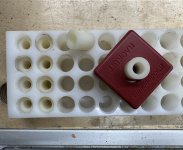Cheese
Member
Well many, many, many years ago before everything became so fancy, I had some Delrin that I milled a series of 1/2" holes into to hold my router bits. For the 1/4" & 3/8" bits (yes 3/8"), I grabbed a piece of 1/2" nylon rod and made a bunch of bushings.
Hey [member=7266]jeffinsgf[/member] with Woodpeckers high speed machining capabilities, these could be cranked out for 3-4 cents each, probably less...certainly cheaper than machining new mold inserts and swapping those out. It could be a quick-fix and may even prove to be a permanent one. [big grin]
[attachimg=1]
Hey [member=7266]jeffinsgf[/member] with Woodpeckers high speed machining capabilities, these could be cranked out for 3-4 cents each, probably less...certainly cheaper than machining new mold inserts and swapping those out. It could be a quick-fix and may even prove to be a permanent one. [big grin]
[attachimg=1]



